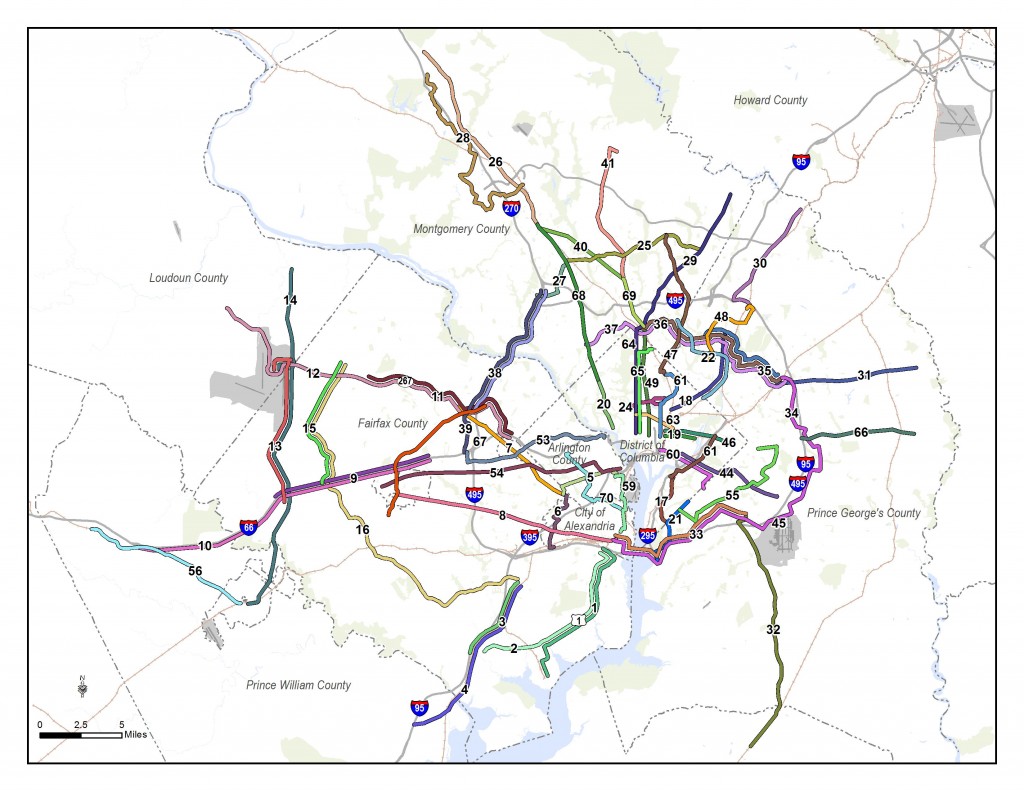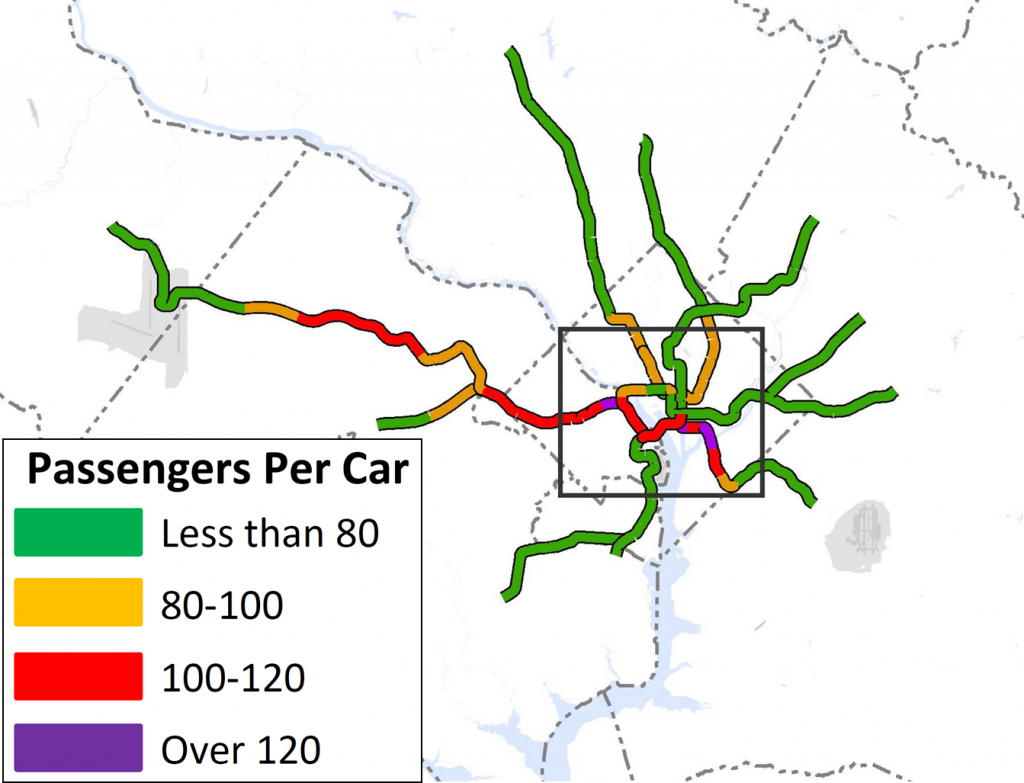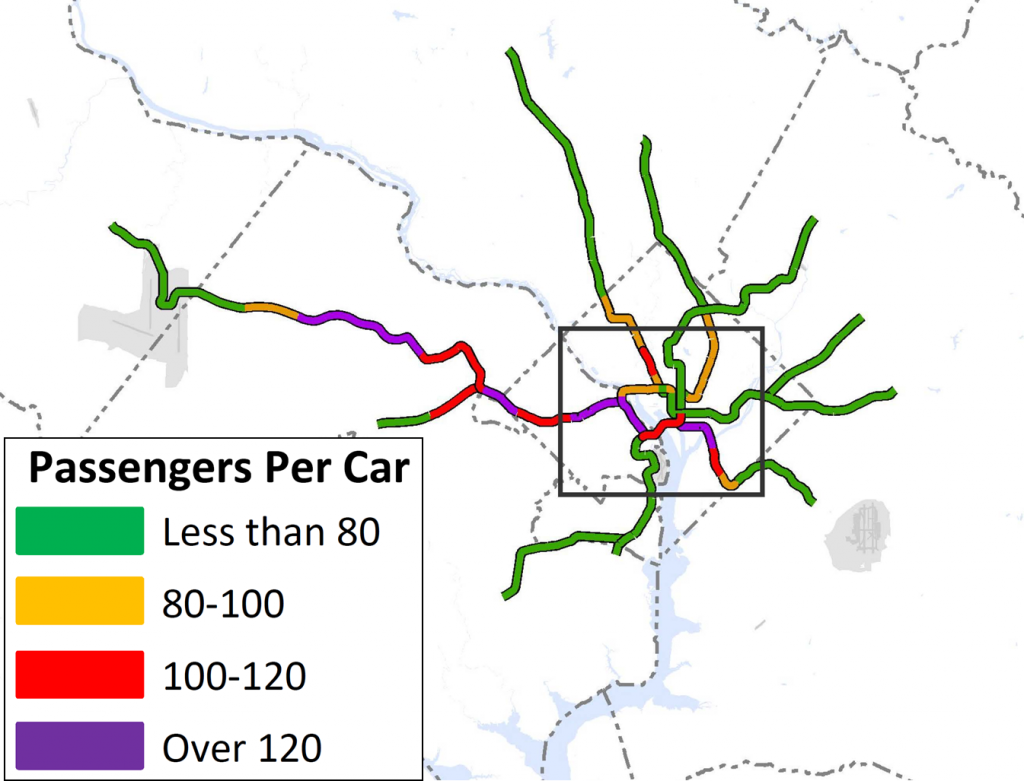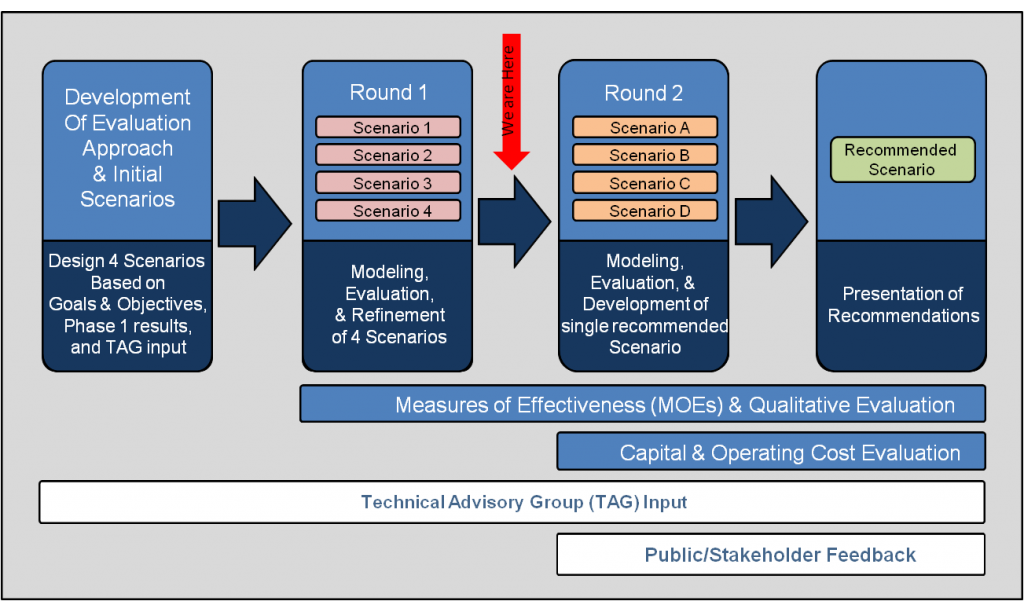This is the second post in a two-part series based  on content from the tenth meeting with the Regional Transit System Plan (RTSP) Technical Advisory Group (TAG) that was held in July. The first post focused on our analysis of new Metrorail lines in the core and Virginia. This post is about our approach to identify regionally significant corridors for high capacity transit.
on content from the tenth meeting with the Regional Transit System Plan (RTSP) Technical Advisory Group (TAG) that was held in July. The first post focused on our analysis of new Metrorail lines in the core and Virginia. This post is about our approach to identify regionally significant corridors for high capacity transit.
By 2040, multiple regionally significant travel corridors will need high capacity, high frequency transit to connect people and jobs outside of the core.
As part of the RTSP, we will identify regionally significant corridors where transit priority infrastructure is needed to provide high capacity transit. At the TAG meeting, Metro Planning staff presented a methodology to identify, evaluate, and prioritize these regionally significant corridors. The methodology has evolved since the July meeting and is described below. The actual evaluation and prioritization is still in process.

Corridors identified for evaluation for high capacity transit.
Since the TAG meeting, we have also conducted one-on-one meetings with each jurisdiction and agency in the RTSP study area to review and gather feedback on the full set of corridors that will be evaluated. Approximately 70 corridors have been identified from:
Read more…
This is the first post in a two-part series based  on content from the tenth meeting with the Regional Transit System Plan (RTSP) Technical Advisory Group (TAG) that was held in July. This post will focus on our analysis of Metrorail capacity and crowding, while the second post will focus on identifying and prioritizing regionally significant surface transit corridors.
on content from the tenth meeting with the Regional Transit System Plan (RTSP) Technical Advisory Group (TAG) that was held in July. This post will focus on our analysis of Metrorail capacity and crowding, while the second post will focus on identifying and prioritizing regionally significant surface transit corridors.
By 2040, ridership and crowding levels on Metrorail indicate the need for a new Blue Line and new Yellow line in the system’s core and a third line in Virginia.
At the time of our last post, we had run an initial round of four scenarios that sought to resolve regional mobility issues. We gathered a lot of information from the results, but realized that we needed to run a second round of scenarios focused almost entirely on Metrorail. Using MWCOG’s Cooperative Forecast Round 8.1 land use, which has been adopted by the region, and MWCOG’s Aspirations land use, which shifts more jobs and households into the regional activity centers, the maps below clearly demonstrate crowded conditions in 2040. The Base Network shown in these maps includes 100 percent eight-car trains and all the CLRP projects. Crowded conditions exist on the Orange Line west of Rosslyn, on the Yellow and Green Lines south of L’Enfant Plaza, and on the Silver Line west of Tysons. Because the results indicated that Metro would be severely crowded EVEN if we run the longest possible trains (eight-car trains), we wanted to explore other long-term solutions.

Crowding on Metrorail by 2040, even with the longest possible (eight-car) trains. Base Network AM Peak, Round 8.1 Cooperative Forecast

Crowding on Metrorail in 2040 even with the longest possible (eight-car) trains, Base Network AM Peak, Aspirations Land Use
Read more…
In September, we presented to the TAG the results of the first round of scenarios modeled in the second phase of the RTSP study. Scenarios are defined by a collection of strategies or projects identified in the initial phase of the RTSP. The four scenarios tested focused on maximizing the existing infrastructure, expanding surface transit, expanding transit in the core, and expanding transit system wide. The performance of each scenario was evaluated against a set of measures to determine the relative effectiveness of each compared to the baseline scenario, defined by the regional list of projects in the currently adopted Constrained Long Range Plan, and MWCOG Cooperative Forecasts Round 8.0 land use.

Phase II Process Overview: Click to Enlarge
Regional measures such as total transit trips, mode share, vehicle miles traveled, households and jobs within a half-mile of transit, travel time savings, and transit congestion were evaluated to not only determine how well the scenarios performed against each other over the baseline, but to assess how well each satisfied the goals and objectives of the RTSP. In addition to these broad-based regional measures, the first round of scenario modeling focused on how well each scenario addressed the need to expand capacity within the system core. Peak period Metrorail link capacity and transfer activity at key core stations were measured against the baseline scenario to determine if the potential build scenarios could provide sufficient capacity to serve future demand, and how well such added capacity could be utilized.
For more information on scenario descriptions, measured results, and key findings download meeting materials: TAG 9 Presentation of Results
Read more…
Metro is developing the Regional Transit System Plan (RTSP), a vision of a sustainable, integrated, multimodal, regional transit net work for 2040. Metro staff have recently completed the first phase, and presented a summary to the Technical Advisory Group (TAG) in January. Phase II is underway, and the proposed approach and initial scenarios to evaluate were also presented to the TAG.
work for 2040. Metro staff have recently completed the first phase, and presented a summary to the Technical Advisory Group (TAG) in January. Phase II is underway, and the proposed approach and initial scenarios to evaluate were also presented to the TAG.
During the initial phase, Metro staff assessed future growth trends and travel-demand patterns throughout the region for the forecast year 2040. Regional growth, reported by MWCOG Cooperative Forecasts Round 7.2a, shows significant population, household, and employment growth over the next several decades. This growth has a direct impact on travel patterns around the region. As a part of Phase I work, Metro staff identified the implications this has for transit.
Forecasts show that with the implementation of the projects included in the 2009 financially constrained long-range plan (CLRP) regional transit trips will grow by 30% by 2040. Although the regional program of projects in the CLRP results in a transit mode share remaining at only 4% of total person trips, the region will see more than 350,000 new weekday transit trips. Given the anticipated growth and dispersion of travel, the RTSP focuses on the following long-range issues:
- Increasing the capacity of the system to serve the region’s employment core;
- Improving multimodal access to high quality transit;
- Improving the efficiency and interoperability of the region’s surface transit;
- Improving connections to Regional Activity Centers;
Read more…
May 5, 2011

In May, we continued to provide the TAG with model results of several strategies aimed to improve surface transit in the region, such as an enhanced priority corridor network, streetcar network, and light rail extensions. This round of modeling also tested new Metrorail lines including a beltway line and new brown line. Finally, additional Metrorail enhancements were considered such as a relocated silver line with a Ballston-Rosslyn bypass, and a new set of extensions to suburban activity centers. The results of these model runs show the impact of each of these strategies on weekday transit boardings by mode, Metrorail boardings by line, regional transit share, regional transit linked trips, as well as an examination of passengers per rail car during the peak hour. The strategies modeled during this round address the need to increase core system capacity, connect to new and emerging markets, and provide priority for and enhancements to surface transit corridors in the region – three of the four goals of the RTSP.
Download the Meeting Materials: TAG_07_Meeting.pdf (PDF, 3.1 MB)
 In January 2011 we continued to provide the TAG with model results of several strategies designed to provide more access to transit. The model results of these strategies highlight the myriad methods that can be employed to meet future transit demand in the Washington metropolitan area. During this presentation we also presented the proposed RTSP public engagement strategy; a revised project schedule and solicited jurisdictional representatives for additional strategies they would like to see modeled.
In January 2011 we continued to provide the TAG with model results of several strategies designed to provide more access to transit. The model results of these strategies highlight the myriad methods that can be employed to meet future transit demand in the Washington metropolitan area. During this presentation we also presented the proposed RTSP public engagement strategy; a revised project schedule and solicited jurisdictional representatives for additional strategies they would like to see modeled.
TAG Meeting #6 Presentation (PDF)
October 21, 2010

In the fall, we continued to provide the TAG with model results of several strategies designed to support the goals of increasing core capacity, providing adequate access and enhancing surface transit. The model results of these strategies highlight the myriad methods that can be employed to meet the goals of the RTSP and their varied impacts, ranging from moderate to significant.
TAG Meeting 05 – October 21 2010 FINAL (PDF, 3.86MB)
July 15, 2010
 The planning process for the RTSP has been an iterative one which allows for the exchange of information and feedback from the TAG members. The fourth meeting of the TAG included a review of the model results of the Base Case or Max CLRP and these strategies: New North-South Yellow Line on 10th Street, SW/NW; and a New North-South Yellow Line on 2nd Street, SE/NE. The results of these model runs showed the impact of each of these strategies on the passengers per rail car during the peak hour and the impact of rail inter-lining at key rail transfer points like L’Enfant Plaza, Rosslyn and Metro Center. These strategies address the need to increase core rail system capacity, one of the goals of the RTSP.
The planning process for the RTSP has been an iterative one which allows for the exchange of information and feedback from the TAG members. The fourth meeting of the TAG included a review of the model results of the Base Case or Max CLRP and these strategies: New North-South Yellow Line on 10th Street, SW/NW; and a New North-South Yellow Line on 2nd Street, SE/NE. The results of these model runs showed the impact of each of these strategies on the passengers per rail car during the peak hour and the impact of rail inter-lining at key rail transfer points like L’Enfant Plaza, Rosslyn and Metro Center. These strategies address the need to increase core rail system capacity, one of the goals of the RTSP.
TAG Meeting 4 Presentation (3MB, PDF)
What is the Technical Advisory Group (TAG)
 The RTSP Technical Advisory Group (TAG) is convened for the express purpose of reviewing the work products, data and recommendations developed by the RTSP study team during the planning process. The TAG members will be responsible for providing the team with timely information, briefing their respective organizations and informing the team of current transportation plans, proposals and operations which are relevant to the development of the RTSP 2040.
The RTSP Technical Advisory Group (TAG) is convened for the express purpose of reviewing the work products, data and recommendations developed by the RTSP study team during the planning process. The TAG members will be responsible for providing the team with timely information, briefing their respective organizations and informing the team of current transportation plans, proposals and operations which are relevant to the development of the RTSP 2040.
Read more…
May 20, 2010
 After providing the Technical Advisory Group (TAG) with data and information on the future transit demand and growth patterns, during the 3rd TAG Meeting, Metro staff shared with the TAG some of the opportunities and challenges discussed with the various regional jurisdictions in their respective meetings. During this meeting the TAG also discussed the development of a website and blog to keep the public engaged in the RTSP process and to hear their thoughts on transit service in the year 2040. The TAG reviewed and discussed proposed strategies to meet the future transit demand and the process by which we would evaluate and measure those strategies. The RTSP Strategies would then be modeled, refined and evaluated individually to determine their impact on future transit demand.
After providing the Technical Advisory Group (TAG) with data and information on the future transit demand and growth patterns, during the 3rd TAG Meeting, Metro staff shared with the TAG some of the opportunities and challenges discussed with the various regional jurisdictions in their respective meetings. During this meeting the TAG also discussed the development of a website and blog to keep the public engaged in the RTSP process and to hear their thoughts on transit service in the year 2040. The TAG reviewed and discussed proposed strategies to meet the future transit demand and the process by which we would evaluate and measure those strategies. The RTSP Strategies would then be modeled, refined and evaluated individually to determine their impact on future transit demand.
TAG Meeting 03 – May 2010
 on content from the tenth meeting with the Regional Transit System Plan (RTSP) Technical Advisory Group (TAG) that was held in July. The first post focused on our analysis of new Metrorail lines in the core and Virginia. This post is about our approach to identify regionally significant corridors for high capacity transit.
on content from the tenth meeting with the Regional Transit System Plan (RTSP) Technical Advisory Group (TAG) that was held in July. The first post focused on our analysis of new Metrorail lines in the core and Virginia. This post is about our approach to identify regionally significant corridors for high capacity transit. 







 The RTSP Technical Advisory Group (TAG) is convened for the express purpose of reviewing the work products, data and recommendations developed by the RTSP study team during the planning process. The TAG members will be responsible for providing the team with timely information, briefing their respective organizations and informing the team of current transportation plans, proposals and operations which are relevant to the development of the RTSP 2040.
The RTSP Technical Advisory Group (TAG) is convened for the express purpose of reviewing the work products, data and recommendations developed by the RTSP study team during the planning process. The TAG members will be responsible for providing the team with timely information, briefing their respective organizations and informing the team of current transportation plans, proposals and operations which are relevant to the development of the RTSP 2040.
Recent Comments